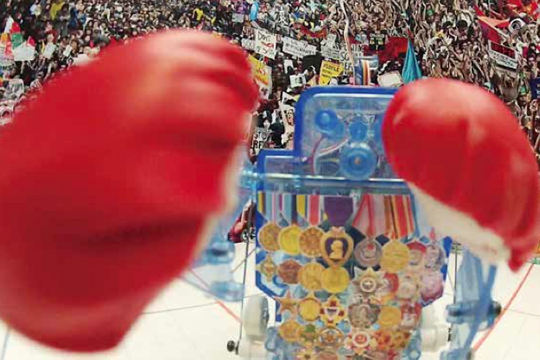ACTION… CUT!
| June 5, 2013 | Post In LEAP 20

For the art audience in Jakarta, Yuz Museum has its particular position, which is quite different from other spaces in the city. Yuz Museum has a focus on showing Chinese contemporary art, especially from its collection, which is quite distanced from Indonesian audiences. In the beginning of its establishment, Yuz Museum had shown important figures in Chinese contemporary such as Yue Minjun, Zhang Xiaogang, Xu Bing, and many others. To open their program this year, Yuz Museum surprisingly decided to exhibit representatives of a younger generation of artists, particularly those who had studied outside of China. “Action… Cut!” shows three of them: Liu Xinyi, Wang Taocheng, and Ye Funa.
Beyond academic background, curator Tian Jing uses the idea of performative possibilities/methods as the framework of her curatorial concept. She sees each of the artists as an actor in a variety show, each playing his or her own role in their own space. In her curatorial text, furthermore, she employs the term “role” towards questioning the role of artists (as well as of curators and other art practitioners) in society. Occupying five floors, the artworks of these three artists are presented more as three different solo presentations than as one whole connected group show. In terms of space and narrative, the relationship and dialogue between the works are not so visible. Somehow, we can tell that there is a line that connects the notion of memory and social political context between the artworks, but in the sense of how these contexts are interwoven, this is not explored any further. Liu Xinyi is interested in observing global political situations as a viewer and as audience, making commentary from a well-maintained distance. This interest in global politics is influenced by his experience of living in London during his studies at Goldsmiths. Here, visitors are greeted by the large scale and extreme visibility of his Universal Protest Banner, and its slogan “YOU ARE DAMN WRONG.” The installation Civil Diplomacy consists of spring-grip dumbbells that he painted over with the national flags of the 10 economically biggest countries in the world. The audience may play with the dumbbells, so as to simulate tensions and intimation between two countries— they either fight or form a coalition. Liu’s playful approach of using humor to represent politics is also underlined in his work Elizabeth, for which he changed the figure of the Queen on British coins to demonstrate the aging process of this otherwise untouchable woman.
Wang Taocheng, who occupies the third floor, shows a series of paintings that captures the contradictions of shadow and visibility, of material and non-material, and of masculinity and femininity. The Portrait Practice departs from the idea of discarding the juxtapositions of landscape painting and of re-questioning many different traditions of paintings in China. Here, layers of white silkscreen cover up the paintings, thus intervening in the direct interaction of the audience with the picture plane.
Ye Funa sits in between Liu Xinyi and Wang Taocheng in terms of the discourse of public and individual, of social context and personal matters. Ye traces the history of contemporary China through the documentation of her own family, where she herself performs everyone else in old photographs, video, and family tree drawings, recreating the whole scene exactly as was in the originals. This action could be considered as re-staging the past from the perspective of the present, drifting in between individual subjectivities.
The metaphor of actor, and also, the notion that the whole world is a theater, seems a promising approach for these three different practices. Yet each of them possesses a monologue of its own story and narrative, and the correlation between actors is not visible in this exhibition. This stage, somehow, is without a proper accompanying orchestra, and feels a bit too empty.

